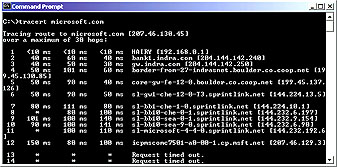|
|
|
In March issue of PC World (Page 150), I talked about how to use the Ping command and a Microsoft Web site to troubleshoot sluggish Net connections. I received a lot of mail about the item, mostly requests for additional help, so let's take a closer look. But first, here's a follow-up on another March tip. The URL we printed for Microsoft's Bandwidth Speed Test works, but if you don't have a cable or DSL connection, you'll get better results with www.computingcentral.com/topics/bandwidth/speedtest.asp. Now some more about Ping: It's a great tool when it makes contact with the server on the other end. But when Ping returns a 'request timed out' message, it could mean any number of things. The most likely of these is that the request simply timed out-the connection was so slow that Ping gave up waiting for a response from the remote server. On the other hand, the time-out message could mean that the destination site is simply ignoring you. For whatever reason (probably because thousands of Ping requests are sent to their servers), many large sites may decide to turn off the software that replies to Ping requests. So don't be surprised if certain addresses never seem to respond to your request. Ping can also be misleading in other ways. A Web server bogged down with users may nevertheless respond promptly to Ping requests, for example. Despite these quirks, this utility's forte is testing whether your connection is working at all - if the connection seems dead, and half a dozen or more sites time out when you ping them, you probably have a basic failure to communicate. Start over, this time checking your modem settings, dial-in number, and IP and DNS addresses. Take the trace route: If Ping reveals that your Internet connection is functional but frustratingly slow, you need to know where the problem lies. Perhaps things have bogged down somewhere beyond your ISP's control (and yours). Or the problem could be closer to home-in your home, even. To pinpoint the bottleneck's location, use the Tracert command. Like Ping, the command-short for trace route-is part of Windows 95, 98, NT, and 2000. As its name implies, Tracert follows the path that data takes between your computer and any remote address you communicate with. To trace the route between your system and Microsoft's Web site, for example, open a command prompt window (select StartòRun, then type command), type tracert microsoft.com, and then press <Enter>. 
Tracert's text output (see FIGURE 2) shows you how quickly data travels between your location and each network router along the way. As with Ping, time displayed is in milliseconds, and larger numbers mean slower performance. Tracert tests each new network segment (these are known as hops) three times and posts all three numbers. A star in place of a number signifies a time out. If Tracert reports times in single or double digits for the first five or six hops but then suddenly encounters a segment in the high triple digits, you have found your slowdown-or at least part of it. The bad news: The Internet is slow. The good news: It's probably not your fault or your ISP's. If slow Ping times consistently commence on the second or third hop, your ISP will probably want to know about it-the backbone service it connects to, the high-speed lines it uses to connect to the backbone, or the ISP's own internal network or servers may be faulty. If the problem shows up on the first hop, however, it most likely involves either your equipment or the phone company's. Review your basic modem and network settings, as well as the physical phone wiring both inside and outside your home or office. Disconnect all other phones and telephone devices that you use, including your answering and fax machines, to determine if they might be responsible for the problem. If you become a habitual pinger and trace-router, you may want to pick up some extra-strength tools. NeoTrace, a graphical trace-route utility that charts route performance and plots the path on a map of the world. Download an evaluation copy from www.neotrace.com or simply get it off our cover CD. The registration fee is $30. PingPlotter, is a program which combines ping and trace-route tools in a graphical interface. The program ($15) is available on this months cover CD.Scott Spanbauer |
Category:Internet Issue: July 2000 |
These Web pages are produced by Australian PC World © 2000 IDG Communications